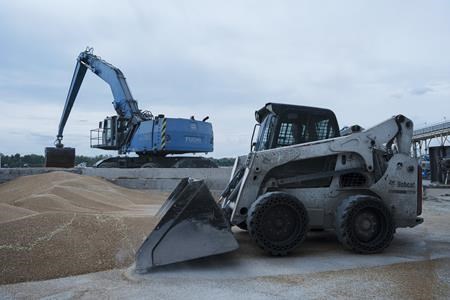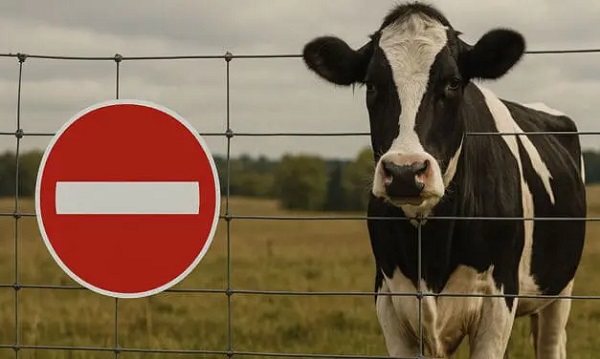Alberta
Russia has halted a wartime deal allowing Ukraine to ship grain. It’s a blow to global food security

LONDON (AP) — Russia halted a breakthrough wartime deal on Monday that allows grain to flow from Ukraine to countries in Africa, the Middle East and Asia where hunger is a growing threat and high food prices have pushed more people into poverty.
Kremlin spokesman Dmitry Peskov said Russia would suspend the Black Sea Grain Initiative until its demands to get its own food and fertilizer to the world are met. While Russia has complained that restrictions on shipping and insurance have hampered its agricultural exports, it has shipped record amounts of wheat.
“When the part of the Black Sea deal related to Russia is implemented, Russia will immediately return to the implementation of the deal,” Peskov said.
The suspension marks the end of an accord that the U.N. and Turkey brokered last summer to allow food to leave the Black Sea region after Russia’s invasion of its neighbor worsened a global food crisis. The initiative is credited with helping lower soaring prices of wheat, vegetable oil and other food commodities.
Ukraine and Russia are both major global suppliers of wheat, barley, sunflower oil and other affordable food products that developing nations rely on.
The grain deal provided assurances that ships won’t be attacked entering and leaving Ukrainian ports, while a separate agreement facilitated the movement of Russian food and fertilizer. While Western sanctions do not apply to Moscow’s agricultural shipments, some companies may be wary of doing business with Russia because of the measures.
Ukrainian President Volodymyr Zelenskyy’s adviser, Mykhailo Podolyak, said the suspension was expected and believes it’s political theater.
“The statement itself immediately includes an escape clause,” he said. “Therefore, we are dealing with classic public techniques of the Russian Federation that no longer require significant reciprocal reactions.”
Turkish President Recep Tayyip Erdogan said the country’s foreign minister would speak with his Russian counterpart Monday — and that he was hopeful the deal would be extended.
The suspension of the deal sent wheat prices up about 3% in Chicago trading, to $6.81 a bushel. Analysts don’t expect more than a temporary bump to food commodity prices because places like Russia and Brazil have ratcheted up wheat and corn exports, but food insecurity worldwide is growing.
The Black Sea Grain Initiative has allowed three Ukrainian ports to export 32.9 million metric tons of grain and other food to the world, more than half of that to developing nations, according to the Joint Coordination Center in Istanbul.
The agreement was renewed for 60 days in May, but in recent months, the amount of food shipped and number of vessels departing Ukraine have plunged, with Russia accused of preventing additional ships from participating.
The war in Ukraine sent food commodity prices to record highs last year and contributed to a global food crisis also tied to other conflicts, the lingering effects of the COVID-19 pandemic, droughts and other climate factors.
High costs for grain needed for food staples in places like Egypt, Lebanon and Nigeria exacerbated economic challenges and helped push millions more people into poverty or food insecurity.
Rising food prices affect people in developing countries disproportionately, because they spend more of their money on meals. Poorer nations that depend on imported food priced in dollars also are spending more as their currencies weaken and they are forced to import more because of climate change. Places like Somalia, Kenya, Morocco and Tunisia are struggling with drought.
Under the deal, prices for global food commodities like wheat and vegetable oil have fallen, but food was already expensive before the war in Ukraine and the relief hasn’t trickled down to kitchen tables.
“The Black Sea deal is absolutely critical for the food security of a number of countries,” and its loss will compound the problems for those facing high debt levels and climate fallout, said Simon Evenett, professor of international trade and economic development at the University of St. Gallen in Switzerland.
The U.N. Food and Agriculture Organization said this month that 45 countries need outside food assistance, with high local food prices “a driver of worrying levels of hunger” in those places.
The grain deal has faced setbacks since it was brokered by the U.N. and Turkey: Russia pulled out briefly in November before rejoining and extending the deal.
In March and May, Russia would only extend the deal for 60 days, instead of the usual 120. The amount of grain shipped per month fell from a peak of 4.2 million metric tons in October to 1.3 million metric tons in May, the lowest volume since the deal began.
Exports expanded in June to a bit over 2 million metric tons, thanks to larger ships able to carry more cargo.
Ukraine has accused Russia of preventing new ships from joining the work since the end of June. Joint inspections meant to ensure vessels only carry grain and not weapons that could help either side also have slowed considerably.
Asked Monday whether an attack on a bridge connecting the Crimean Peninsula to Russia was a factor in the decision on the grain deal, the Kremlin spokesman said it was not.
Meanwhile, Russia’s wheat shipments hit all-time highs following a large harvest. It exported 45.5 million metric tons in the 2022-2023 trade year, with another record of 47.5 million metric tons expected in 2023-2024, according to U.S. Department of Agriculture estimates.
___
AP reporters Hanna Arhirova in Kyiv, Ukraine, and Andrew Wilks in Istanbul contributed.
___
See AP’s complete coverage of the war in Ukraine at https://apnews.com/hub/russia-ukraine and the food crisis at https://apnews.com/hub/food-crisis.
Courtney Bonnell, The Associated Press
Alberta
Alberta health care blockbuster: Province eliminating AHS Health Zones in favour of local decision-making!

Hospital Based Leadership: Eliminating the bureaucratic vortex in hospitals
Since Alberta’s government announced plans to refocus the health care system in November 2023, a consistent message has emerged from patients, front-line health care workers and concerned Albertans alike about the flaws of the prior system. Alberta Health Services’ current zone-based leadership structure is overly complex and bureaucratic. It lacks the flexibility and responsiveness needed to effectively support facilities and staff – particularly when it comes to hiring, securing supplies and adopting necessary technologies.
That’s why Alberta’s government is changing to a hospital-based leadership structure. On-site leadership teams will be responsible for hiring staff, managing resources and solving problems to effectively serve their patients and communities. Hospitals will now have the flexibility to respond, freedom to adapt and authority to act, so they can meet the needs of their facilities, patients and workforce in real time.
“What works in Calgary or Edmonton isn’t always what works in Camrose or Peace River. That’s why we’re cutting through bureaucracy and putting real decision-making power back in the hands of local hospital leaders, so they can act fast, hire who they need and deliver better care for their communities.”
“Hospital-based leadership ensures decisions on hiring, supplies and services are made efficiently by those closest to care – strengthening acute care, supporting staff and helping patients get the timely, high-quality care they need and deserve.”
“By rethinking how decisions are made, we’re working to improve health care through a more balanced and practical approach. By removing delays and empowering our on-site leaders, we’re giving facilities the tools to respond to real-time needs and ultimately provide better care to Albertans.”
AHS’ health zones will be eliminated, and acute care sites will be integrated into the seven regional corridors. These sites will operate under a new leadership model that emphasizes site-level performance management. Clear expectations will be set by Acute Care Alberta, and site operations will be managed by AHS through a hospital-based management framework. All acute care sites will be required to report to Acute Care Alberta based on these defined performance standards.
“Standing up Acute Care Alberta has allowed AHS to shift its focus to hospital-based services. This change will enable the local leadership teams at those hospitals to make site-based decisions in real and tangible ways that are best for their patients, families and staff. Acute Care Alberta will provide oversight and monitor site-level performance, and I’m confident overall hospital performance will improve when hospital leadership and staff have more authority to do what they know is best.”
“AHS is focused on reducing wait times and improving care for patients. By shifting to hospital-based leadership, we’re empowering hospital leaders to make real-time decisions based on what’s happening on the ground and respond to patient needs as they arise. It also means leaders can address issues we know have been frustrating, like hiring staff where they’re needed most and advancing hospital operations. This change enables front-line teams to act on ideas they see every day to improve care.”
The Ministry of Hospital and Surgical Health Services, Acute Care Alberta and Alberta Health Services will work collaboratively to design and establish the new leadership and management model with an interim model to be established by November 2025, followed by full implementation by summer 2026.
Quick facts
- Countries like the Netherlands and Norway, and parts of Australia have already made the shift to hospital-based leadership.
- The interim hospital-based leadership model will be implemented at one site before being implemented provincewide.
- Hospital-based leadership, once implemented, will apply only to AHS acute care facilities. Other acute care organizations will not be affected at the time of implementation.
Related information
Alberta
Alberta is investing up to $50 million into new technologies to help reduce oil sands mine water

Technology transforming tailings ponds
Alberta’s oil sands produce some of the most responsible energy in the world and have drastically reduced the amount of fresh water used per barrel. Yet, for decades, operators have been forced to store most of the water they use on site, leading to billions of litres now contained largely in tailings ponds.
Alberta is investing $50 million from the industry-funded TIER system to help develop new and improved technologies that make cleaning up oil sands mine water safer and more effective. Led by Emissions Reduction Alberta, the new Tailings Technology Challenge will help speed up work to safely reclaim the water in oil sands tailing ponds and eventually return the land for use by future generations.
“Alberta’s government is taking action by funding technologies that make treating oil sands water faster, effective and affordable. We look forward to seeing the innovative solutions that come out of this funding challenge, and once again demonstrate Alberta’s global reputation for sustainable energy development and environmental stewardship.”
“Tailings and mine water management remain among the most significant challenges facing Alberta’s energy sector. Through this challenge, we’re demonstrating our commitment to funding solutions that make water treatment and tailings remediation more affordable, scalable and effective.”
As in other mines, the oil sands processing creates leftover water called tailings that need to be properly managed. Recently, Alberta’s Oil Sands Mine Water Steering Committee brought together industry, academics and Indigenous leaders to identify the best path forward to safely address mine water and reclaim land.
This new funding competition will support both new and improved technologies to help oil sands companies minimize freshwater use, promote responsible ways to manage mine water and reclaim mine sites. Using technology for better on-site treatment will help improve safety, reduce future clean up costs and environmental risks, and speed up the process of safely addressing mine water and restoring sites so they are ready for future use.
“Innovation has always played an instrumental role in the oil sands and continues to be an area of focus. Oil sands companies are collaborating and investing to advance environmental technologies, including many focused on mine water and tailings management. We’re excited to see this initiative, as announced today, seeking to explore technology development in an area that’s important to all Albertans.”
Quick facts
- All mines produce tailings. In the oil sands, tailings describe a mixture of water, sand, clay and residual bitumen that are the byproduct of the oil extraction process.
- From 2013 to 2023, oil sands mine operations reduced the amount of fresh water used per barrel by 28 per cent. Recycled water use increased by 51 per cent over that same period.
- The Tailings Technology Challenge is open to oil sands operators and technology providers until Sept. 24.
- The Tailings Technology Challenge will invest in scale-up, pilot, demonstration and first-of-kind commercial technologies and solutions to reduce and manage fluid tailings and the treatment of oil sands mine water.
- Eligible technologies include both engineered and natural solutions that treat tailings to improve water quality and mine process water.
- Successful applicants can receive up to $15 million per project, with a minimum funding request of $1 million.
- Oil sands operators are responsible for site management and reclamation, while ongoing research continues to inform and refine best practices to support effective policy and regulatory outcomes.
Related information
-

 Health1 day ago
Health1 day agoLast day and last chance to win this dream home! Support the 2025 Red Deer Hospital Lottery before midnight!
-

 Aristotle Foundation1 day ago
Aristotle Foundation1 day agoThe Canadian Medical Association’s inexplicable stance on pediatric gender medicine
-

 conflict1 day ago
conflict1 day ago“Evacuate”: Netanyahu Warns Tehran as Israel Expands Strikes on Iran’s Military Command
-

 Energy1 day ago
Energy1 day agoCould the G7 Summit in Alberta be a historic moment for Canadian energy?
-

 Bruce Dowbiggin1 day ago
Bruce Dowbiggin1 day agoWOKE NBA Stars Seems Natural For CDN Advertisers. Why Won’t They Bite?
-

 Crime1 day ago
Crime1 day agoMinnesota shooter arrested after 48-hour manhunt
-

 Alberta1 day ago
Alberta1 day agoAlberta announces citizens will have to pay for their COVID shots
-

 Uncategorized1 day ago
Uncategorized1 day agoKananaskis G7 meeting the right setting for U.S. and Canada to reassert energy ties





